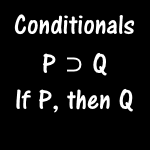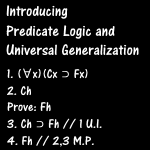This video begins a series on the rules of inference, which are deductively valid argument forms. This video covers the rules of conjunction, simplification, addition, and disjunctive syllogism.
This video introduces the concept of formal validity. This is deductive validity that depends only on the form of an argument. So, any argument with the same form as a formally valid argument is also valid, even if the content of the premises is completely different. The rules of inference are all valid argument forms. So, any argument using a rule of inference as its form is deductively valid.
Since premises and conclusions are propositions, the nature of propositions is discussed before moving on to the rules of inference. The following are true of propositions:
- A proposition is something that is true or false.
- Although propositions are expressed with sentences, a proposition is the meaning of the sentence, not the words, marks, or sounds used to express it. So, different sentences may express the same proposition.
- A proposition is distinct from the words, marks, or sounds used to express it.
- Not all sentences are propositions.
- Although a proposition may be thought, and no one would have any notion of propositions without thinking them, propositions are not the thoughts of them. The same proposition may be thought by different people in different times.
- A proposition is not any concrete thing or quality it might be about. The proposition that the sky is blue is not identical with the sky nor with the color blue. Like numbers, propositions are completely abstract.
- Although a proposition must be true or false, this does not mean that we must know whether it is true or false.
- A proposition is always true or always false. It does not change its truth value over time.
The rules of conjunction and simplification use the & sign. This means AND, and where p and q are each propositions, p & q means that p and q are both true, or, which is the same thing, that the conjunction of them is true.
The rule of conjunction goes from two propositions to their conjunction:
P
Q
∴ P & Q
The rule of simplification lets you infer a single proposition from the conjunction of two propositions:
P & Q
∴ P
The rules of addition and disjunctive syllogism use the v sign. This means OR, and p v q means that p or q is true. This is an inclusive or. This means that p v q is true when either p or q is true or both are true. It is false only when both p and q are false. An or statement is called a disjunction. The two propositions in a disjunction are called disjuncts.
The rule of addition lets you infer a disjunction from a single proposition. As long as the proposition is true, any disjunction with it will also be true. So it doesn’t matter what the new disjunct is.
P
∴ P v Q
The rule of disjunctive syllogism lets you infer one of the disjuncts of a disjunction when you know that the other one is false. Since at least one disjunct in a true disjunction will be true, knowing that one is false tells you that the other one is true. Note that this rule introduce the ~ sign to mean NOT. ~P means that P is false.
P v Q
~P
∴ Q



